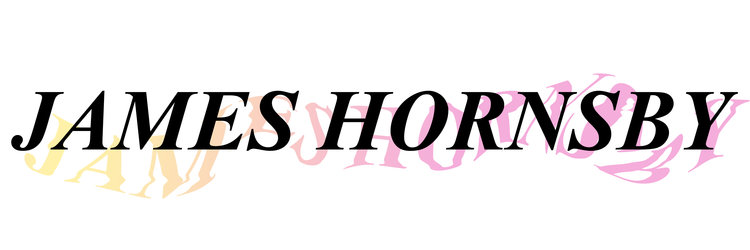The Future is Cancelled: James Hornsby’s Visual Meltdown
“The Machine” they exclaimed, “feeds us and clothes us and houses us; through it we speak to one another, through it we see one another, in it we have our being. The Machine is the friend of ideas and the enemy of superstition: The Machine is omnipotent, eternal; blessed is the Machine.” —E. M. Forster, The Machine Stops, 1909, p. 19
Hi Vis Fumes is James Hornsby’s first solo show at Onespace Gallery. It comprises a suite of new photographic and mixed-media artworks presented in an immersive, site-specific installation created especially for this showcase. The through line of Hornsby’s practice is the degeneration of psychosocial cohesion under the hyper-mediated and technologically complex conditions of 21st century life. Hornsby routinely collages references to horror films, video games, punk rock, psychedelics, tropical landscapes and eroticism through a dizzying high-fructose visual language idiosyncratic to the internet. These are amphetamine-rich virtual geographies that tread a fine line between libidinous commercialisation and full-blown insanity. Hornsby reveals a world within which the ramifications of technological acceleration can be seen in high definition. He harnesses the converging shock waves of global upheavals on our social imagination, abstaining entirely from soothing our malaise.
For those of us who grew up in the early 1990s, during the spring of the household computer, Hornsby’s work can be downright frightening. It’s a far cry from that idyllic Windows wallpaper, suitably titled Bliss, of an impossibly perfect (yet relatively unedited) photograph of rolling green hills and a blue sky awash with fluffy white clouds. Our early encounters with machines were synonymous with unbridled optimism, a time when the future was thriving, unfolding effortlessly in front of us—think ‘edutainment’ programs such as Eyewitness, Scholastic, The Magic School Bus, SimCity, and Encarta. Arguably, the most significant of these programs was Microsoft Paint. Many of us— Hornsby included—cut our teeth in ‘artistic practice’ with this simple graphics editor, establishing the digital as our vernacular medium of expression. These were programs and computers that we trusted, that emboldened us with a sense of agency in the world. Above all, these were computers we could turn off. There’s even a Facebook group called ‘Utopian Scholastic Designs from a Pre-9/11 World’ that memorialises this bright-eyed, bushy-tailed moment. Fast forward to Hornsby’s work today and we can almost make out the comforting curve of that pristine hillside, but those verdant grasslands have long since gone to seed. The unruly terrain now pulsates with the disorder of YouTube ‘autoplay’, 15 second TikTok videos, and the incessant ‘New Posts’ notifications of Instagram. There seems to be no discernible path back to that bucolic bliss, no way back to consensus reality.
In a time when much of contemporary art depends on cool intellectual strategies to examine the challenges of today, Hornsby chooses a more sensual approach, affording us a pre-frontal bypass, a desire path to perceptual and emotional immediacy. This can be disorienting for audiences conditioned to a slower cadence of information processing. Hornsby’s artwork is a visual affront—an explosion of colours, textures and symbolic invocations co-mingling in a pictorial Petri dish. Viewed from a distance, many of his works could be mistaken for abstract paintings and there are important parallels to this artistic genre. Hornsby excavates his subconscious and attacks the picture plane with endless layers of expressive gestures. However, unlike the abstract expressionists of the 20th century, Hornsby chooses machines and software over canvas and paint. That’s not to say his work is totally devoid of tactile action. His photographic prints are frequented by over-painted marks made by hand and anarchist spray can. But it’s within the digital realm that the real work is done. As cameras and code evolve into more and more porous media, so too do artists’ use of them. Over the last decade alone, imaging technologies have transformed beyond recognition; it’s increasingly difficult to identify where the hardware begins and the software ends. This fluidity allows Hornsby to ride the ouroboros cycle of the ‘real’ and the ‘virtual’. His works are becoming increasingly intuitive, transmuting the raw material of photography into pigment for the digital paintbrush tool. Hornsby’s skill lies in his ability to successfully map the terrain of our current emotional habitat while teetering on the edge of material breakdown. The subjects and narratives of his artworks are receding into the background, into the cellular components of the virtual environment. This brings into high relief the infrastructure of the digital world that is otherwise largely invisible and immaterial.
Hi Vis Fumes is a clever title, evoking an unnerving paradox. We feel the whiplash of dignified hard yakka versus the tyranny of invisible work-site hazards, a potent metaphor for ‘business as usual’ while the canary song fades. These are the perils of proletariat romanticism. Hornsby’s work tunes us to the beating drums of danger. He is the doula of meltdowns, rejecting the stiff upper lip and relieving us of our duty to ‘keep calm and carry on’. Here, we find ourselves engaged in emergency foreplay—an artistic escape room providing us a ‘safe space’ to rehearse (and prepare for) the worst-case scenario.
Julia Scott Green
